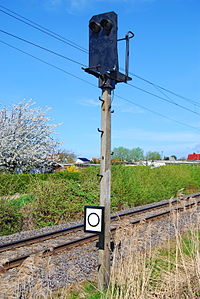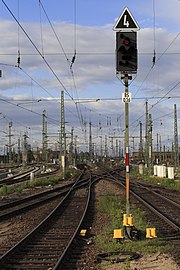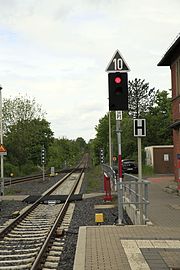OpenRailwayMap/Tagging in Germany/Main and Distant Signals
This page is part of the signal tagging scheme for railway signals in Germany (signals defined by ESO and additional signals used on that railway lines).
Hl Signals
Hl signalling system has been introduced by Deutsche Reichsbahn (railway company of GDR) after 1945 and is a signal which has combined signals (i.e. main and distant signal aspects are combined at one signal).
Hl signals can be found all over former GDR and West Berlin on railway lines/stations whose signal boxes have not been replaced by electronic signal boxes yet. (numbers of this signal are decreasing from year to year)
Hl Distant Signals
Hl distant signals have a distant signal sign (Ne 2) or a repeater sign (white sign with black circle), photographs at Simon Walter's website
- railway:signal:distant=DE-ESO:hl
- railway:signal:distant:form=light
- railway:signal:distant:states=DE-ESO:hl1;DE-ESO:hl4;DE-ESO:hl7;DE-ESO:hl10
- railway:signal:distant:shortened=yes/no Is the distance between distant signal and main signale shorter than usual? Such signals have a Ne 2 sign with an black circle in the center of Ne 2 sign.
- railway:signal:distant:repeated=yes/no Is it a repeater? Such signals are marked by a white sign with a black circle.
- If the signal can show marker light, add
DE-ESO:kennlichtto railway:signal:distant:states=*. (formerly tagged usingrailway:signal:distant:marker_light=yes/no) - If the signal can be turned off without showing marker light, add
offto railway:signal:distant:states=* (similar to Zs 2, Zs 2v, Zs 3, Zs 3v)
Hl Combined Signals
Hl combined signals have a pole sign which consists out of two parts. The top one is white-red-white and the bottom one is a yellow triangle pointing to the ground.
They show a combined signal which consists out of a main and a distant signal aspect. The upper two lights show the distant aspect (green = expect full speed, green flashing = expect 100 kph, yellow flashing = expect 40 or 60 kph, yellow = expect stop). The lower left light is yellow. It is turned on if the speed is limited to 40 kph. The lower right light is an ersatz red light (if the center red fails).
There may be additional four or eight lights below the signal forming two rows. One row is yellow, one green. If the yellow row is on the speed is limited to 60 kph, if the green row is on, the speed is limited to 100 kph. The lower left yellow light is turned on in both cases. If the train may pass the signal with full speed, these two rows and the lower left yellow light are off. In that case, only one of the upper lights is turned on or flashing (it shows the distant signal aspect).
You cannot say which of the two rows can show the green and which one the yellow bar because it is not unique over all Hl signals.
Note, that a signal which has a yellow bar sometimes cannot show 40 kph aspect because there is not switch behind the signal which needs a 40 kph aspect.
photographs at Simon Walter's website,
- railway:signal:combined=DE-ESO:hl
- railway:signal:combined:form=light
- railway:signal:combined:states=DE-ESO:hp0;DE-ESO:hl1;DE-ESO:hl2;DE-ESO:hl3a;DE-ESO:hl3b;DE-ESO:hl4;DE-ESO:hl5;DE-ESO:hl6a;DE-ESO:hl6b;DE-ESO:hl7;DE-ESO:hl8;DE-ESO:hl9a;DE-ESO:hl9b;DE-ESO:hl10;DE-ESO:hl11;DE-ESO:hl12a;DE-ESO:hl12b possible aspects, depending on the available lights
- railway:signal:combined:function=entry/exit/intermediate/block signal function either
entry,exit,blockorintermediate - railway:signal:combined:substitute_signal=DE-ESO:dr:zs1/DE-ESO:db:zs12 substitute signal Zs 1 (flashing white light) or a M sign (Zs 12). Note that Zs 1 often uses the same light as Sh 1 does.
- If the signal can show marker light, extend railway:signal:combined:states=* by
DE-ESO:kennlicht railway:signal:combined:marker_light=yes/no Can the signal show marker light?deprecated tagging, replaced byDE-ESO:kennlicht- If the signal can be turned dark without displaying a marker light, extend railway:signal:combined:states=* by
off(like Zs 2, Zs 2v, Zs 3, Zs 3v)
Hl Main Signals
Hl main signals (i. e. such without distant signal aspects) do not have a yellow light at the left top corner and/or do not have a yellow triangle at sign at their pole. photographs by Simon Walter
- railway:signal:main=DE-ESO:hl
- railway:signal:main:form=light
- railway:signal:main:states=DE-ESO:hp0;DE-ESO:hl1;DE-ESO:hl2;DE-ESO:hl3a;DE-ESO:hl3b;DE-ESO:hl4;DE-ESO:hl5;DE-ESO:hl6a;DE-ESO:hl6b possible aspects depending on avialbable lights
- railway:signal:main:function=entry/exit/intermediate/block Use
entry,exit,blockorintermediatedepending on the signal's function - railway:signal:main:substitute_signal=DE-ESO:dr:zs1/DE-ESO:db:zs12 Which replacement signal aspect can be shown? Either Zs 1 (Ersatzsignal) or a Zs 12 (M-Tafel).
- If the signal can display a marker light, add
DE-ESO:kennlichtto railway:signal:main:states=*. railway:signal:main:marker_light=yes/no Can the signal show a marker light?deprecated tagging, replaced byDE-ESO:kennlicht- If the signal can be turned off without displaying a marker light, add
offto railway:signal:main:states=* (similar to Zs 2, Zs 2v, Zs 3, Zs 3v)
Hp Signals
Hp Semaphore Signals
Hp semaphore signals are the oldest main signals which are still in use.
Main signals which can show Hp 2, photographs by Simon Walter
- railway:signal:main=DE-ESO:hp
- railway:signal:main:form=semaphore
- railway:signal:main:states=DE-ESO:hp0;DE-ESO:hp1
- railway:signal:main:function=entry/exit/intermediate/block Use
entry,exit,blockorintermediatedepending on the signal's function - railway:signal:main:substitute_signal=DE-ESO:db:zs1/DE-ESO:dr:zs1/DE-ESO:db:zs7/DE-ESO:db:zs12 Which replacement signal aspect can be shown? Either Zs 1 of former DB (Ersatzsignal, three lights) or Zs 1 of former DR (Ersatzsignal, one flashing light) or a Zs 7 (Vorsichtsignal, three yellow lights forming V) or a Zs 12 (M-Tafel, sign with a red hand-written M)
Main signals which cannot show Hp 2, photographs by Simon Walter
- railway:signal:main=DE-ESO:hp
- railway:signal:main:form=semaphore
- railway:signal:main:states=DE-ESO:hp0;DE-ESO:hp1;DE-ESO:hp2
- railway:signal:main:function=entry/exit/intermediate/block Use
entry,exit,blockorintermediatedepending on the signal's function - railway:signal:main:substitute_signal=DE-ESO:db:zs1/DE-ESO:dr:zs1/DE-ESO:db:zs7/DE-ESO:db:zs12 Which replacement signal aspect can be shown? Either Zs 1 of former DB (Ersatzsignal, three lights) or Zs 1 of former DR (Ersatzsignal, one flashing light) or a Zs 7 (Vorsichtsignal, three yellow lights forming V) or a Zs 12 (M-Tafel, sign with a red hand-written M)
Hp Light Signals
Hp light signals have been introduced in West Germany after World War II and existing in several variations. There had been some similar signals in East Germany after World War II before Hl signalling system was introduced but they have been used only at very few locations and all signals of this type in East Germany had been dismounted already. There are some Hl signals in Berlin (West and East) which look like Hp signals but show Hl signal aspects and there are some Hp signals in erlin (West and East) which display Hp signal aspects. (i.e. be carefully if you map Berlin S-Bahn signals)
Licht-Blocksignale, photographs by Simon Walter
- railway:signal:main=DE-ESO:hp
- railway:signal:main:form=light
- railway:signal:main:states=DE-ESO:hp0;DE-ESO:hp1
- railway:signal:main:function=entry/exit/intermediate/block Use
entry,exit,blockorintermediatedepending on the signal's function - railway:signal:main:substitute_signal=DE-ESO:db:zs1/DE-ESO:dr:zs1/DE-ESO:db:zs7/DE-ESO:db:zs12 Which replacement signal aspect can be shown? Either Zs 1 of former DB (Ersatzsignal, three lights) or Zs 1 of former DR (Ersatzsignal, one flashing light) or a Zs 7 (Vorsichtsignal, three yellow lights forming V) or a Zs 12 (M-Tafel, sign with a red hand-written M)
- If the signal can display a marker light, add
DE-ESO:kennlichtto railway:signal:main:states=*. railway:signal:main:marker_light=yes/no Can the signal show a marker light?deprecated tagging, replaced byDE-ESO:kennlicht- If the signal can be turned off without displaying a marker light, add
offto railway:signal:main:states=* (similar to Zs 2, Zs 2v, Zs 3, Zs 3v)
Licht-Ausfahr-, Einfahr- oder Zwischensignal, Bildbeispiele auf der Website von Simon Walter
- railway:signal:main=DE-ESO:hp
- railway:signal:main:form=light
- railway:signal:main:states=DE-ESO:hp0;DE-ESO:hp1;DE-ESO:hp2
- railway:signal:main:function=entry/exit/intermediate/block Use
entry,exit,blockorintermediatedepending on the signal's function - railway:signal:main:substitute_signal=DE-ESO:db:zs1/DE-ESO:dr:zs1/DE-ESO:db:zs7/DE-ESO:db:zs12 Which replacement signal aspect can be shown? Either Zs 1 of former DB (Ersatzsignal, three lights) or Zs 1 of former DR (Ersatzsignal, one flashing light) or a Zs 7 (Vorsichtsignal, three yellow lights forming V) or a Zs 12 (M-Tafel, sign with a red hand-written M)
- If the signal can display a marker light, add
DE-ESO:kennlichtto railway:signal:main:states=*. railway:signal:main:marker_light=yes/no Can the signal show a marker light?deprecated tagging, replaced byDE-ESO:kennlicht- If the signal can be turned off without displaying a marker light, add
offto railway:signal:main:states=* (similar to Zs 2, Zs 2v, Zs 3, Zs 3v)
Hp 3 of KVB
![]() Kölner Verkehrs-Betrieben (KVB, Transport Authority of City of Cologne) also uses Hp signals. They can display a Hp 3 aspect. It is a combined aspect (main+distant) and they therefore are tagged as combined signals.
Kölner Verkehrs-Betrieben (KVB, Transport Authority of City of Cologne) also uses Hp signals. They can display a Hp 3 aspect. It is a combined aspect (main+distant) and they therefore are tagged as combined signals.
- railway:signal:combined=DE-KVB:hp
- railway:signal:combined:form=light
- railway:signal:combined:states=DE-ESO:hp0;DE-ESO:hp1;DE-ESO:hp2;DE-KVB:hp3
- railway:signal:combined:function=entry/exit/intermediate/block Use
entry,exit,blockorintermediatedepending on the signal's function - railway:signal:combined:substitute_signal=DE-ESO:db:zs1/DE-ESO:dr:zs1/DE-ESO:db:zs7/DE-ESO:db:zs12 Which replacement signal aspect can be shown? Either Zs 1 of former DB (Ersatzsignal, three lights) or Zs 1 of former DR (Ersatzsignal, one flashing light) or a Zs 7 (Vorsichtsignal, three yellow lights forming V) or a Zs 12 (M-Tafel, sign with a red hand-written M)
- If the signal can show marker light, extend railway:signal:combined:states=* by
DE-ESO:kennlicht railway:signal:combined:marker_light=yes/no Can the signal show marker light?deprecated tagging, replaced byDE-ESO:kennlicht- If the signal can be turned dark without displaying a marker light, extend railway:signal:combined:states=* by
off(like Zs 2, Zs 2v, Zs 3, Zs 3v)
Ks Signals
The Ks signal system is the new signal system which has been introduced after reunification all over Germany. Hp/Hl/Sv signals are replaced by these signals if the signal box is been replaced by an electronic one. It aims to be an simple and unified system and leaves all the disadvantages of its predecessors behind. There are Ks combined signals, Ks distant signals and Ks main signals. photoraphs by Simon Walter
Ks Distant Signals
Ks distant signals do not have a white-red-white sign a their pole. Instead, they have a distant signal sign (Ne 2). Ks distant signals have two lights, a green and a yellow one at the same height. (In some special cases, they have only a yellow light. Ks distant signals in tunnels can look different because they are much smaller) photographs by Simon Walter
- railway:signal:distant=DE-ESO:ks
- railway:signal:distant:form=light
- railway:signal:distant:states=DE-ESO:ks1;DE-ESO:ks2
- railway:signal:distant:shortened=yes/no Is the distance between distant signal and main signale shorter than usual? Such signals have a small white light at the upper left corner.
- railway:signal:distant:repeated=yes/no Is it a repeater? Such signals are marked by a small white light at the lower left corner. They have no distant signal sign (Ne 2).
- If the signal can show marker light, add
DE-ESO:kennlichtto railway:signal:distant:states=*. (formerly tagged usingrailway:signal:distant:marker_light=yes/no) - If the signal can be turned off without showing marker light, add
offto railway:signal:distant:states=* (similar to Zs 2v, Zs 3v)
Ks Combined Signals
Ks Combined Signals have a white-red-white sign and a yellow, triangular sign at their pole. (Signals with a white-black-white-black-white sign at their pole only exist along the tracks of Berlin S-Bahn) photographs by Simon Walter
- railway:signal:combined=DE-ESO:ks
- railway:signal:combined:form=light
- railway:signal:combined:states=DE-ESO:hp0;DE-ESO:ks1;DE-ESO:ks2
- railway:signal:combined:function=entry/exit/intermediate/block Use
entry,exit,blockorintermediatedepending on the signal's function. - railway:signal:combined:shortened=yes/no Is the distance between the signal and the next main/combined signale shorter than usual? Such signals have a small white light at the upper left corner.
- railway:signal:combined:substitute_signal=DE-ESO:dr:zs1/DE-ESO:db:zs7/DE-ESO:db:zs12 substitute signal Zs 1 (flashing white light), caution signal (Zs 7, three yellow light forming a V) or a M sign (Zs 12). Note that Zs 1 usually uses the same light as Sh 1 does.
- If the signal can show marker light, extend railway:signal:combined:states=* by
DE-ESO:kennlicht railway:signal:combined:marker_light=yes/no Can the signal show marker light?deprecated tagging, replaced byDE-ESO:kennlicht- If the signal can be turned dark without displaying a marker light, extend railway:signal:combined:states=* by
off(like Zs 2, Zs 2v, Zs 3, Zs 3v)
Ks Main Signals
Ks Combined Signals have a white-red-white sign at their pole. photographs by Simon Walter
- railway:signal:main=DE-ESO:ks
- railway:signal:main:form=light
- railway:signal:main:states=DE-ESO:hp0;DE-ESO:ks1
- railway:signal:main:function=entry/exit/intermediate/block Use
entry,exit,blockorintermediatedepending on the signal's function. - railway:signal:main:substitute_signal=DE-ESO:dr:zs1/DE-ESO:db:zs7/DE-ESO:db:zs12 substitute signal Zs 1 (flashing white light), caution signal (Zs 7, three yellow light forming a V) or a M sign (Zs 12). Note that Zs 1 usually uses the same light as Sh 1 does.
- If the signal can show marker light, extend railway:signal:combined:states=* by
DE-ESO:kennlicht railway:signal:main:marker_light=yes/no Can the signal show marker light?deprecated tagging, replaced byDE-ESO:kennlicht- If the signal can be turned dark without displaying a marker light, extend railway:signal:main:states=* by
off(like Zs 2, Zs 3)
Sk Signals
Sk signals are a experimental main and distant light signal system which combines main and distant signal aspects in one combined signal. It was (apart from Sv signals in Hamburg) the first combined signal system in West Germany. It is only used between Augsburg and Donauwörth.
Main signals (without distant signal aspects) have a red sign at their pole. Combined signals have a red-yellow sign at their pole. Distant signals have a yellow sign at their pole.
For the full tagging documentation see the German version of this page.
Sv Signals
Sv signals are a very old light signal system and had been invented for the usage at Berlin S-Bahn. They are combined signals. Later, Hamburg S-Bahn started to use them, too. They nowadays only exist in Hamburg. photographs from Hamburg at Wikimedia Commons
Tagging see German version of this page
Vr Signals
Vr signals are distant signals (German "Vorsignale"). photographs by Simon Walter
Vr semaphore signals are the oldes distant signals which are still in use. Vr light signals are only used in West Germany.
Vr Semaphore Signals
- railway:signal:distant=DE-ESO:vr
- railway:signal:distant:form=semaphore
- railway:signal:distant:states=DE-ESO:vr0;DE-ESO:vr1;DE-ESO:vr2 Which aspects can the signal display?
- railway:signal:distant:shortened=yes/no Is the distance between distant signal and main signale shorter than usual? Such signals have a Ne 2 sign with an black circle in the center of Ne 2 sign (East Germany), or a white triangle pointing downwards on top of the Ne 2 (West Germany).
Vr Light Signals
- railway:signal:distant=DE-ESO:vr
- railway:signal:distant:form=light
- railway:signal:distant:states=DE-ESO:vr0;DE-ESO:vr1;DE-ESO:vr2 Which aspects can the signal display?
- railway:signal:distant:shortened=yes/no Is the distance between distant signal and main signale shorter than usual? Such signals have a Ne 2 sign and a white additional light.
- railway:signal:distant:repeated=yes/no Is the signal a repeater? Such signals do not have a Ne 2 but an additional white light.
- If the signal can display marker light, add railway:signal:distant:states=*
DE-ESO:kennlicht. - If the signal can show marker light, add
DE-ESO:kennlichtto railway:signal:distant:states=*. (formerly tagged usingrailway:signal:distant:marker_light=yes/no) - If the signal can be turned off without showing marker light, add
offto railway:signal:distant:states=* (similar to Zs 2v, Zs 3v)
















![Ks main signal with a Zs 3 speed signal and Zs 2 route signal (bottom)]](https://upload.wikimedia.org/wikipedia/commons/thumb/0/07/Clp_20141010_3520_Bf_Gladbeck_West_Asig_50N1.jpg/76px-Clp_20141010_3520_Bf_Gladbeck_West_Asig_50N1.jpg)












